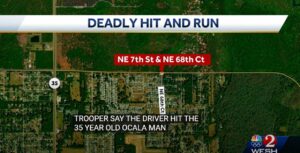
Last month, a 35-year-old Ocala man riding his bike was killed by a hit-and-run driver in Silver Springs. Unfortunately, such incidents occur all too frequently in our area. How can you, as a driver or a bicyclist, avoid a collision? Here are some FAQs you should know:
- What are the key rules bicyclists should follow to avoid accidents with cars in Florida? Bicyclists should always ride in the same direction as traffic, obey traffic signals and signs, use hand signals to indicate turns, and ride as far to the right as practicable. They should also make themselves visible by wearing bright clothing and using lights at night.
- How can drivers prevent accidents with bicyclists in Florida? Drivers should give bicyclists at least three feet of clearance when passing, check their blind spots before turning or changing lanes, and be mindful of bike lanes and cyclists when opening car doors.
- Are there specific laws in Florida regarding the distance drivers should maintain when passing bicyclists? Yes, Florida law requires drivers to give bicyclists at least three feet of clearance when passing them on the road.
- What are some common causes of accidents between bicyclists and cars in Florida? Common causes include failure to yield, distracted driving, speeding, opening car doors without checking for cyclists, and failure to observe right-of-way rules at intersections.
- How important is it for bicyclists and drivers to communicate with each other on the road? Communication between bicyclists and drivers is crucial for safety. Bicyclists should use hand signals to indicate their intentions, while drivers should use turn signals and make eye contact with cyclists when necessary.
- Are there any areas or intersections in Florida where accidents between bicyclists and cars are more likely to occur? Intersections and areas with heavy traffic or poor visibility are more prone to accidents. Additionally, areas where bike lanes intersect with vehicle lanes can be risky if both parties are not vigilant.
- What precautions should bicyclists take when riding at night in Florida? Bicyclists should equip their bikes with front and rear lights that are visible from at least 500 feet away, wear reflective clothing, and avoid wearing dark colors that may make them less visible to drivers.
- Is it legal for bicyclists to ride on sidewalks in Florida? In Florida, bicyclists are generally permitted to ride on sidewalks unless local ordinances prohibit it. However, they must yield the right-of-way to pedestrians and give an audible signal before passing.
- How can both bicyclists and drivers educate themselves about road safety in Florida? Both bicyclists and drivers can take advantage of educational resources provided by organizations like the Florida Department of Transportation, local law enforcement agencies, and cycling advocacy groups. Additionally, attending safety courses or workshops can enhance awareness and understanding of road rules.
- What should I do if I witness an accident between a bicyclist and a car in Florida? If you witness an accident, immediately call emergency services to report the incident. If it’s safe to do so, provide assistance to any injured parties and gather relevant information such as license plate numbers and witness contact details to aid in the investigation. Avoid moving injured individuals unless absolutely necessary to prevent further harm.

